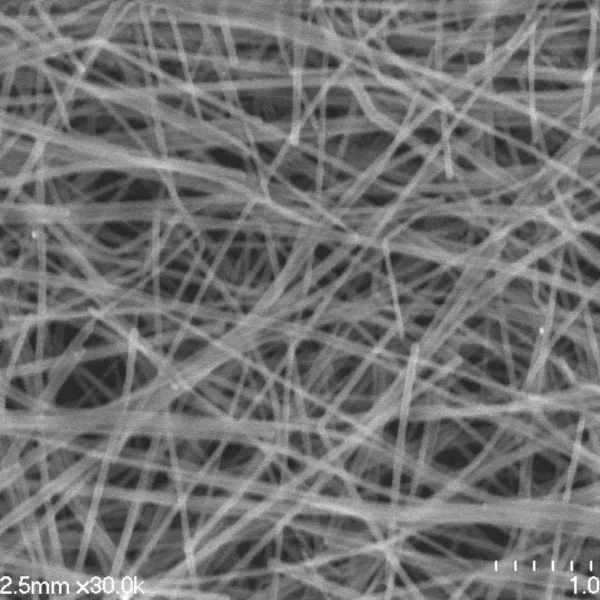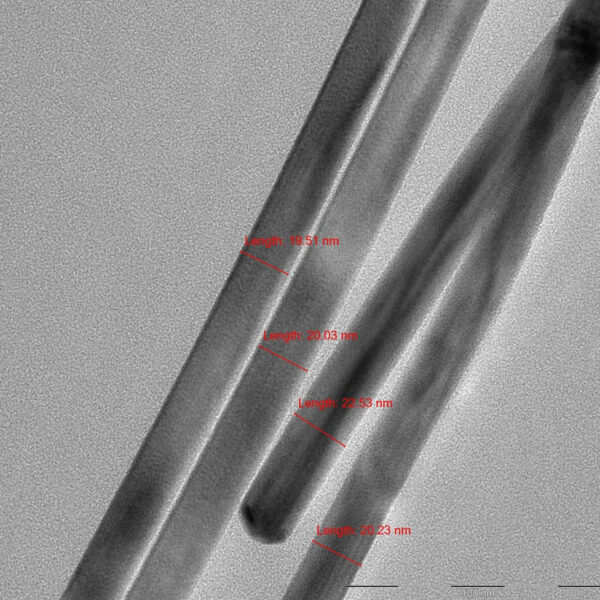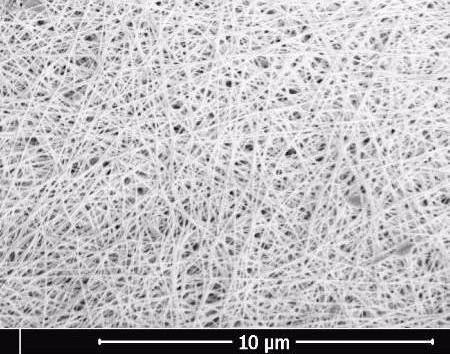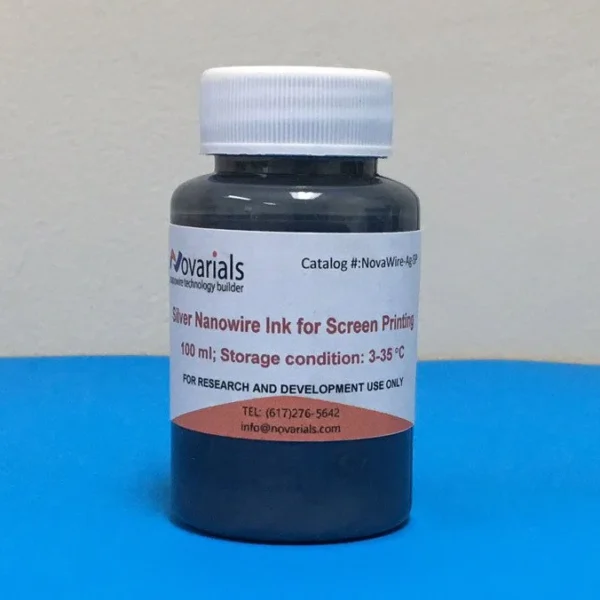Description
The short length silver nanowires have high intrinsic conductivity and low aspect ratio. They are specially designed for fabricating various inkjet printing inks without blocking printer head.
Catalog Number: NovaWire-Ag-A30SL
Average Diameter: ~30nm
Average Length: ~5µm
Appearance: gray suspension (dispersed in solvent)
Dispersion solvent: water, ETH, IPA, or customized
Concentration: 5mg/ml, 10mg/ml, or customized
APPLICATIONS
Silver nanowires are one-dimensional silver nanomaterials which typically have a diameter in a range of 10-200 nm and a length in a range of 5-200um. They have excellent optical, electrical, thermal, and other properties including high electrical and thermal conductivities, low light extinction in the visible, flexibility, and antibacterial characteristics. Due to their unique properties, silver nanowires have been used in a wide range of applications.
- Transparent Conductive Films: Silver nanowires have been used to create transparent conductive films, replacing traditional materials like indium tin oxide (ITO) in applications where transparency and cost-effectiveness are essential. They are important for applications like touchscreens for smartphones, tablets, and other electronic devices. They are also used as transparent electrodes for solar cells, solar panels, thin film photovoltaics, light-emitting diodes (LEDs), OLED devices, and OLED lighting.
- Flexible Electronics: Due to their flexibility, silver nanowires can be incorporated into flexible and stretchable materials for the development of flexible electronic devices, including flexible displays, wearable electronics, flexible antennas, and bendable sensors.
- Printed Electronics: Inks containing silver nanowires can be formulated to allow precise and controlled deposition of silver nanowires onto different substrates through techniques such as inkjet printing and screen printing. This makes silver nanowires highly valuable in the field of printed electronics, enabling cost-effective and scalable manufacturing of electronic components and devices.
- Flexible Transparent Heaters: Silver nanowires are employed in the fabrication of flexible transparent heaters that can generate heat while providing clear visibility. These heaters are suitable for a variety of applications including automotive defrosting, de-icing and smart windows.
- Antibacterial Applications: Due to silver’s inherent antibacterial properties, silver nanowires are utilized to develop antibacterial coatings for medical devices, surfaces and textiles to inhibit bacteria growth and prevent infections, such as bandages, antimicrobial hospital linens and uniforms. They are also used in air and water purification systems, food packaging, door handles, elevator buttons, and handrails.
- Catalysis: Due to their high surface area and surface reactivity, silver nanowires can serve as catalysts in a variety of chemical reactions and environmental remediation processes. They have been employed in the reduction of organic compounds, organic synthesis reactions, oxidation reactions, and degradation of pollutants, and are of great value in the pharmaceutical and chemical industries.
- Sensors: Due to their high sensitivity, flexibility, and compatibility with various substrates, silver nanowires can be incorporated into various types of sensors for detecting and measuring different substances. They can be used in chemical and gas sensors to detect specific gases or analytes such as ammonia, nitrogen dioxide or carbon monoxide. Their high surface area allows the immobilization of biomolecules, such as enzymes or antibodies, enabling their application in biosensors to detect specific biological substances. The resistance of the silver nanowire-based matrices changes in response to pressure and strain, making them useful in pressure sensors and strain sensors.
In addition, silver nanowires are also applied in the following fields:
- Liquid crystal displays
- e-paper
- Fillers for high performance conductive adhesives
- Surface enhanced spectroscopy (SERS)
- Medical imaging
- EMI shielding films and paints
- Optical limiters
- Waveguides
- Compact logic gates
REFERENCES
- Duc Anh Dinh, Kwun Nam Hui, Kwan San Hui, Pushpendra Kumar, Jai Singh, “Silver Nanowires: A Promising Transparent Conducting Electrode Material for Optoelectronic and Electronic Applications”, Reviews in Advanced Sciences and Engineering, 2013, Vol 2, 1–22.
- Yuan-Jun Song, Jing Chen, Jing-Yuan Wu, and Tong Zhang, “Applications of Silver Nanowires on Transparent Conducting Film and Electrode of Electrochemical Capacitor”, Journal of Nanomaterials, 2014, Vol 2014, Article ID 193201, 7 pages.
- Hui-Wang Cui, Katsuaki Suganuma, Hiroshi Uchid, “Highly Stretchable, Electrically Conductive Textiles Fabricated from Silver Nanowires and Cupro Fabrics Using a Simple Dipping-Drying Method”, Nano Research, DOI 10.1007/s12274-014-0649-y.
- Cai-Hong Liu and Xun Yu, “Silver nanowire-based transparent, flexible, and conductive thin film”, Nanoscale Res. Lett. 2011, 6(1), 75.
- Feng Xu, Yong Zhu, “Highly Conductive and Stretchable Silver Nanowire Conductors”, Advanced Materials, 2012, Vol 24, Issue 37, 5117–5122.
- Cheng Y, Wang R, Sun J, Gao L, “Highly Conductive and Ultrastretchable Electric Circuits from Covered Yarns and Silver Nanowires”, ACS Nano, 2015, Mar 30.
- Jingjing Ma, Mao-Sheng Zhan, Kai Wang, “Ultralightweight Silver Nanowires Hybrid Polyimide Composite Foams for High-Performance Electromagnetic Interference Shielding”, ACS Applied Materials & Interfaces , 12/2014; 7(1), DOI: 10.1021/am5067095.
- Amjadi M; Pichitpajongkit A; Lee S; Ryu S; Park I, “Highly Stretchable and Sensitive Strain Sensor Based on Silver Nanowire–Elastomer Nanocomposite”, ACS Nano., 2014, 8(5), 5154-63.
- Tate C. Hauger, S. M. Ibrahim Al-Rafia, and Jillian M. Buriak, “Rolling Silver Nanowire Electrodes: Simultaneously Addressing Adhesion, Roughness, and Conductivity”, ACS Appl. Mater. Interfaces, 2013, 5 (23), 12663–12671.
- Ki-Hun Ok, Jiwan Kim, So-Ra Park, Youngmin Kim, Chan-Jae Lee, Sung-Jei Hong, Min-Gi Kwak, Namsu Kim, Chul Jong Han & Jong-Woong Kim, “Ultra-thin and smooth transparent electrode for flexible and leakage-free organic light-emitting diodes”, Scientific Reports 5, Article number: 9464.
- Weina He, Guangyong Li, Shangquan Zhang, Yong Wei, Jin Wang, Qingwen Li, Xuetong Zhang, “Polypyrrole/Silver Coaxial Nanowire Aero-Sponges for Temperature-Independent Stress Sensing and Stress-Triggered Joule Heating”, ACS Nano, Article ASAP, DOI: 10.1021/acsnano.5b00626, Publication Date (Web): March 26, 2015.
- H. Al-Saleh, G.A. Gelves, U. Sundarara, “Novel Metal Nanowire/Polymer Nanocomposites for Electromagnetic Interference Shielding”, NSTI-Nanotech, 2009, Vol. 2, 505.
- Shanshan Yao and Yong Zhu, “Wearable multifunctional sensors using printed stretchable conductors made of silver nanowires”, Nanoscale, 2014, 6, 2345.
- Ruo-Zhou Li, Anming Hu, Tong Zhang, and Ken D. Oakes, “Direct Writing on Paper of Foldable Capacitive Touch Pads with Silver Nanowire Inks”, ACS Appl. Mater. Interfaces, 2014, 6 (23), pp 21721–21729
- Adam K. Wanekaya, Wilfred Chen, Nosang V. Myung, Ashok Mulchandani, “Nanowire-Based Electrochemical Biosensors”, Electroanalysis, 2006, 18, No. 6, 533–550.
- Yat Li, Fang Qian, Jie Xiang, Charles M. Lieber, “Nanowire electronic and optoelectronic devices”, Materials Today, Volume 9, Issue 10, October 2006, Pages 18–27.
SYNONYM
Silver nanowires, silver nanofibers, silver, Ag nanowires, Ag nanofibers, Ag, metallic nanowires, metallic nanofibers, conductive nanowires, conductive nanofibers, conductive inks, conductive pastes, silver nanowire, silver nanofiber, Ag nanowire, Ag nanofiber, metallic nanowire, metallic nanofiber, conductive nanowire, conductive nanofiber, conductive ink, conductive paste
SDS






